Selling on eBay and other auction sites
Opinions
All opinions expressed on this page are mine (Terry Cox.) They reflect the recording of over 63,000 certificate sales from eBay (as of December, 2023) as well as countless thousands of views of items that never sold. They reflect conversations with correspondents as well as observations expressed at an eBay conference held in Denver in the 2000s. Opinions, of course, also reflect my own purchases and eBay sales.
Readers should feel to ignore all suggestions and discover their own the tricks and pitfalls of selling on eBay. It won't hurt my feelings in the slightest. I merely advise keeping records of successes and failures to determine what works and what doesn't.
Selling on auction sites is not for everyone
Certificates are sold continuously on eBay and a few other sites. The y are also on on Etsy and elsewhere in fixed price formats. Nonetheless,. eBay is the hands-down 900 pound gorilla where practically ever amatuer seller turns to sell collectible stocks and bonds. I am going to talk exclusively about problems and possibilities I see on eBay, although almost every comment applies elsewhere. I do not have time to those other sites with any regularity, but I want to hear about experiences on other platforms — both positive and negative.
Sooner or later, all collectors – or their heirs – must consider selling collections. Selling to another collector, or even several, will be tough because of differing interests. Selling to dealers often involves the fear of being taken advantage of. Selling through auction houses involves the fear of selling substantially below market. Selling through eBay seems easy, but is neither free nor free of hazards. When considering selling, I strongly advise entering the process of liquidating collections with eyes wide open.
All images on this page are mine. I shot them in ways to imitate the most common presentation problems I see on eBay. All were purposely shot with a cell phone in less than perfect lighting.
Sellers need to know what they intend to accomplish
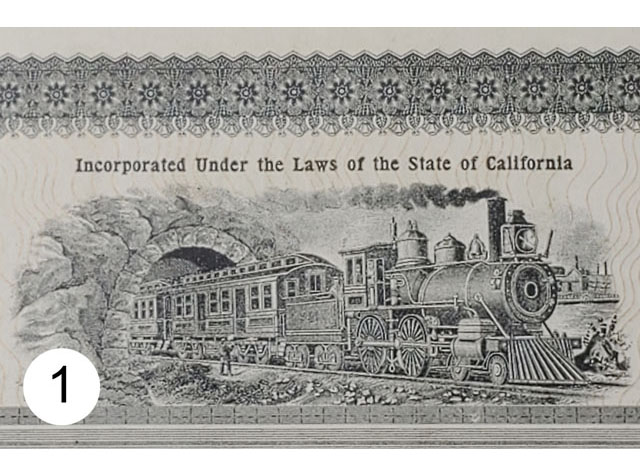
|
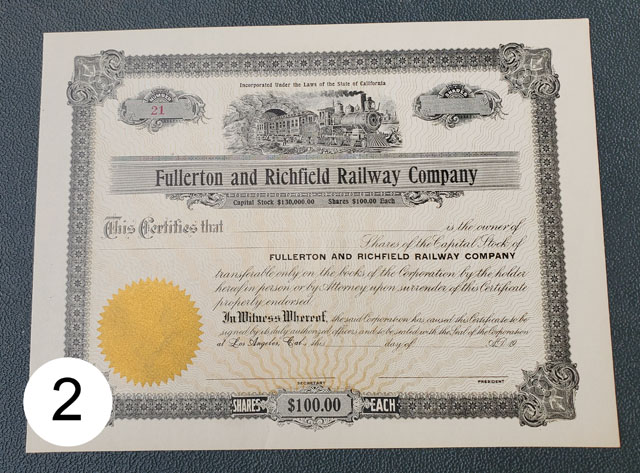
|
|
Which of these items are customers really buying?
(They are buying certificates with vignettes, not vignettes themselves.)
|
No matter which method of liquidation they choose, sellers need to be 100% clear about their motives. Are they after a fast sale at any price? Are they trying to sell at elevated prices in order to recover much of their original investments? Are they selling rarities they think are worthy of strong bids?
If they are trying to dump material quickly, and don't care how much money they make, they can simply group items into multi-item auction lots with low starting bids. Practically anything will sell with low start prices. They will not make any money, but they be rid of stuff they didn't want.
The more money sellers want to receive, the more they will need to improve their game. That means better images and better descriptions. It means fair starting prices. The people who make the most money on eBay are the ones who are most professional in their appearances and approaches. Profitable sellers make potential customers feel the most comfortable. Buyers perceive risk when buying from people they don't know. They want to know precisely what they are bidding on. Tell them and show them.
Avoid fixed price offerings. Although eBay is now a predominantly fixed-price platform. My analyses prove auctions result in more sales and better prices
Sellers don't need to sell everything on eBay
Unless a seller's collection is small and made up mostly of common material, I do not suggest selling all of their collection on eBay. I advise selling desirable and rare items to dealers or through professional auction houses. I recommend using eBay to sell material that dealers don't need and professional auction houses relegate to multi-item lots.
A place to sell entry-level and mid-level certificates
Collectors who choose to liquidate duplicates or re-position their collections often choose eBay. EBay is probably the most effective way for collectors to sell low-priced, beginner-style material to other collectors. Most professional dealers are over-stocked with those kinds of certificates. I don't know any professional dealers who are enthusiastic about acquiring more.
I am seeing an increasing number of mid-level certificates offered on eBay. I believe most are sold too cheaply and it is not unusual to see such items appear a few months later in professional auctions. That is where Better Buyers congregate and where items of medium and high scarcity sell at elevated prices.
How to get started
Experienced collectors are good at buying, but they commonly have little experience selling to people they don't know. I advise them to "test the waters" before they (or their heirs) actually need to sell. There are loads of suggestions and how-tos about selling on eBay. Take advantage of that knowledge. Remember that anyone who writes on the subject of eBay selling has probably already made ALL the beginner mistakes.
This page is for would-be, part-time, and maybe even experienced sellers
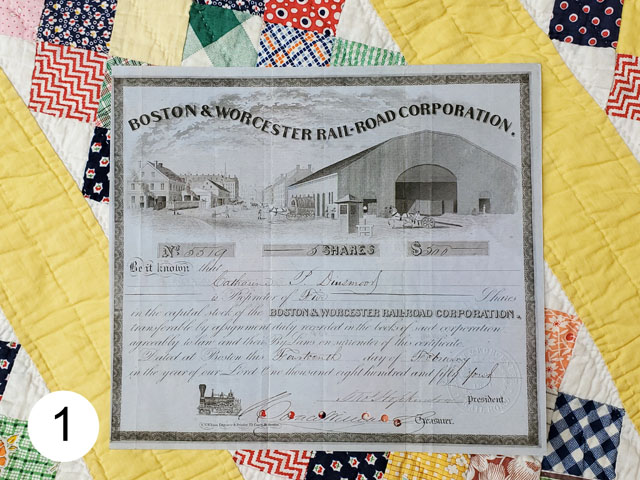
|
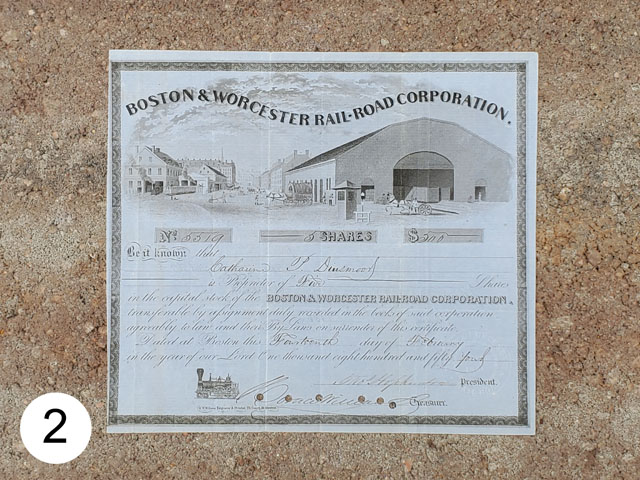
|
|
Which background focuses attention on the certificate being sold?
(Avoid distracting backgrounds.)
|
Anyone new to selling is going to start at a disadvantage. They are going to compete with more experienced sellers.
Fortunately, there is a great trick to learn about selling before ever listing anything on eBay. Simply step back and study other sellers. Identify the sellers who seem to be selling more than others. Find those sellers by looking at sold items on eBay. Their screen names will appear week after week. What are they doing that other sellers aren't? Is it their page displays? Their photos? Their descriptions? Their inventories? Their prices? Are they using bold lettering? Are they selling with auctions or fixed price offers? What kinds of items are they selling? Low price? Medium price? Common? Scarce?
Sellers shouldn't just LOOK at listings, though. RECORD what sellers are doing that separates them from the crowd. Then, do the same. Imitate the best.
Once would-be sellers begin quantifying what experienced sellers are doing, they will inevitably wonder, "What can I do better?"
Experienced sellers can ask themselves the same things. Are there things they could be doing better? Are they describing inventory as well as they could? Are they listing in the best category. Are they making customers feel good about buying from them? Could they streamline their fulfillment process? Are they including promotional material with their packaging? Are they making enough money?
I record sales from eBay every day and I see some astoundingly poor efforts at selling. If I were to ask those sellers only one thing, it would be:
"Can't you at least TRY to do fewer things wrong?"
Find out what eBay prices are REALLY like
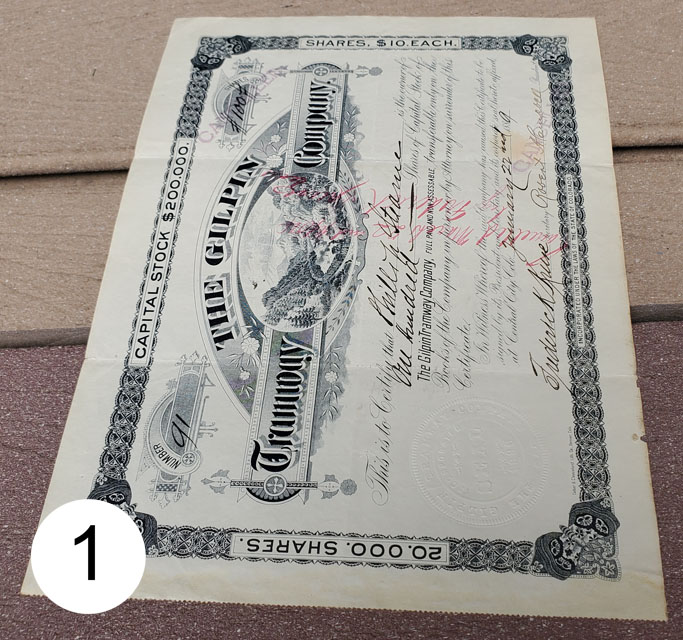
|
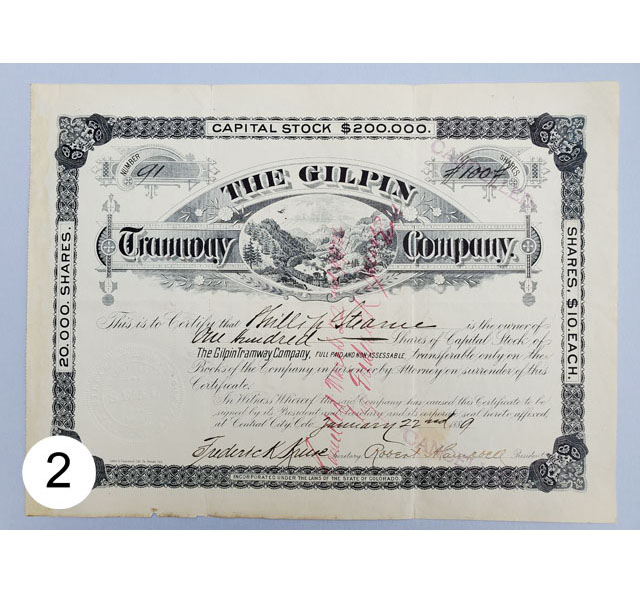
|
|
Which image better illustrates the item being sold?
(Avoid distortion and rotated images.)
|
It is a bad practice to estimate prices in a vacuum. EBay gives users the ability to "look back" at items that have sold over the last three months. Sellers are going to be highly disappointed if they offer something at $50 when it has never sold on eBay for more than $20. Simply put, greed and self-delusion do not work on eBay. The market wins every time.
What do buyers want?
It is enlightening to look at eBay listings from the perspectives of buyers. The age-old adage of Know your customer is as true on eBay as everywhere else.
Sellers cannot know much about their buyers before the fact, but they can certainly generalize.
- The majority of the best certificate buyers are going to be collectors (as opposed to dealers and accumulators.) Cater to collectors.
- Beginning collectors and collectors on budgets want to spend as little as possible. Sell items with acceptably low (but not stupid low) start prices in auction formats. Avoid fixed price listings because new collectors will know which prices are fair and which are not. Auctions allow them to learn
- Buyers of very cheap certificates are likely beginners. Most collectors new to the scripophily hobby already have experience in other hobbies and will be quick studies. While some want to buy one of everything, budgets force most into loose specialties fairly quickly. It will be difficult to make a viable business catering strictly to beginners.
- Most collectors develop some sort of specialty. Don't try to predict their specialties. Be diverse in offerings.
- Budget issues affect a substantial percentage of collectors. I suggest it is unwise to throw many highly similar items into the market at one time. If liquidating numbers of similar certificates, spread them out over a period of a several months to give time for budget-minded collectors to refresh their hobby funds.
- Collectors with a few years of experience know a lot about their specialties. They will ignore chattering about rarity, low serial numbers, beautiful vignettes, famous companies, or company officers. Long company histories wasate time and DO NOT convince them to buy. Company names and states of issuance are probably the best verbal marketing ploys.
- Most collectors DO NOT read anything other than the listing title before bidding.
"Bargain hunters" and "accumulators" are not generally long-term nor serious buyers. Bargain hunters will often send messages to sellers through eBay and ask for "deals." They frequently sound serious, but rarely are. Bargain hunters may be useful for dumping quantities of low-grade, common material, but they tend to disappear as quickly as they appear. Unless those are the kinds of customers sellers are after, I advise wasting very few words in answering most inquiries, if they even deserve an answer at all.
Make buyers comfortable
All buyers, no matter the sizes of their wallets or specialties want one universal thing; their want assurance that they will receive what they believe they are buying. Sooner or later, every collector will get "burned" by a purchase. It is therefore sellers' responsibilities to decrease the perception of risk. After all, buyers are doing business with someone they have never met. The sooner eBay sellers embrace that reality, the sooner they can learn to describe, photograph, and sell their certificates more effectively. The easiest way for sellers to learn about future customers is to reflect on how they have collected. What did THEY want to know when buying? What made them want to buy from one source and avoid another?
Think mail order
EBay selling starts with
VERY FEW WORDS AND A PICTURE
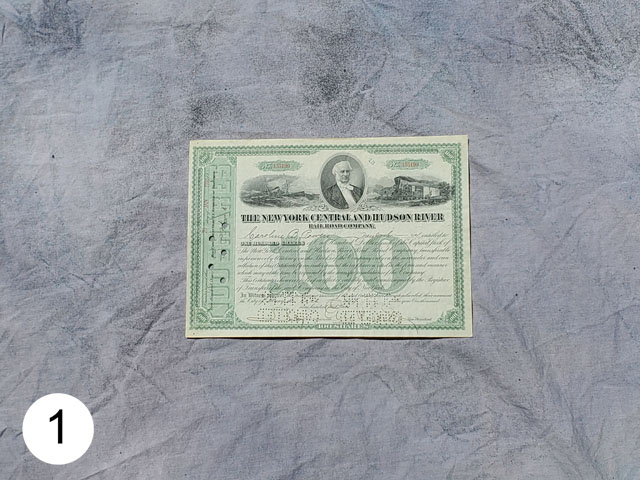
|
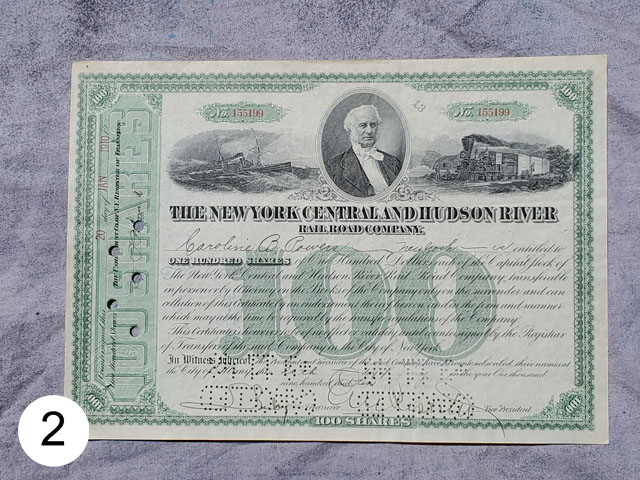
|
|
Does unused margin really help sell?
(Certificates are the important subjects; show them as large as possible.)
|
EBay is the equivalent of one tremendously large newspaper classified section. It is the "Classified Ad Section" for the entire world.
Like classified ads, sellers have incredibly little time to separate themselves from the crowd. The ONLY tools they have are 80 characters and a tiny picture.
Once sellers grab attentions of would-be buyers, they have only a second or two to pull buyers into their offerings. The only things they have to work with are pictures, a few words, and a price. That's it.
That reality should be more than enough to convince sellers to ramp up their games. They must do what their competitors will not. They must realize what game they are playing.
The game they are playing is good old-fashioned mail order with ONE BIG DIFFERENCE.
Sellers attract customers in mail order by focusing precisely on the types of customers they want to acquire. The tighter sellers focus on desired customers, the better their responses. The BIG DIFFERENCE with eBay is that eBay gives sellers absolutely no control over the number, quality, attitude, experience, or wealth of the people who will view their listings. The only way sellers can attract and cater to the kinds of customers they want is through:
- the categories where they place listings
- listing format (auction versus fixed price)
- how they title their 80-character max listings
- image quality
- realistic and competitive prices
Every choice is critical, and yet, a tremendous number of eBay sellers ignore them. Not on purpose, of course. But they seemingly fail to understand they are playing the mail order game.
Sellers of certificates will do themselves a big favor by reading several time-worn books on how to sell by mail. The only thing different between now and fifty years ago is how sellers go about finding buyers. Everything else – presentation, copywriting, order fulfillment, customer relations – remains the same. In short, eBay sellers must do everything full-fledged mail order companies do without the ability to pre-select customers.
Fortunately, there IS one trade-off
EBay gives sellers an advantage old-time mail order did not have: large, full-color images.
Images tell tremendous amounts about items. Significant percentages of eBay buyers purchase solely on the basis of pictures. The tendency is so strong that many eBay sellers have abandoned copywriting entirely. Some even go so far as to describe certificates with "See photos" and nothing else.
Although eBay buyers rarely seem to read descriptions, selling certificates with no description is ***NOT*** effective selling. Sellers need to use all the tools available to them. That means proper category placement, large, full-color images, excellent title wording, informative descriptions, and 100% focus on items being sold.
One more thing. By not describing items being sold, sellers are opening themselves up to returns and bad reviews based on problems that could not be seen in photos alone.
Don't be lazy

Many eBay sellers are just plain lazy.
Admittedly, it takes extra time to become good at selling, but isn't the goal to make more money?
In one respect, laziness is not all bad. It gives rest to the weary and distinct advantages to sellers who make extra efforts to make their offerings look better and more informative.
I want to be clear. I am not saying that every bit of extra effort will result in more sales or higher sales. I am saying that my recording of eBay sales since 2001 proves that professional dealers and professional-looking sellers statistically outsell amateurs. Not in every sale, of course, but over the long run.
Observations of sales attempts on eBay and elsewhere
Several factors affect how successful sellers will be when selling on eBay:
- The number of interested collectors who will notice their offers
- Placement of listings in proper categories
- The quality of images
- Words used in listing titles
- Accuracy and focus of descriptions.
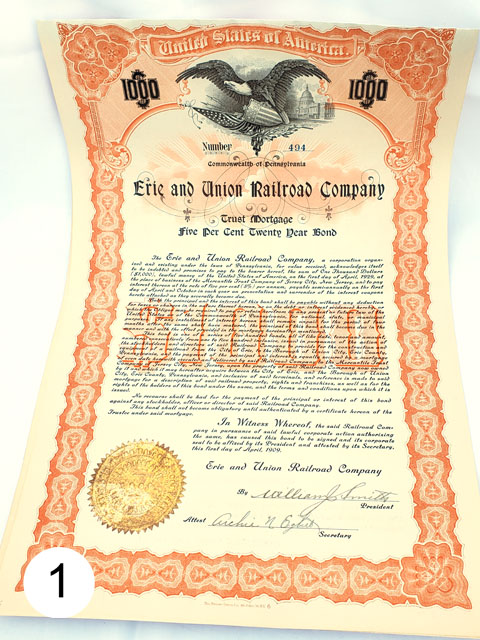
|
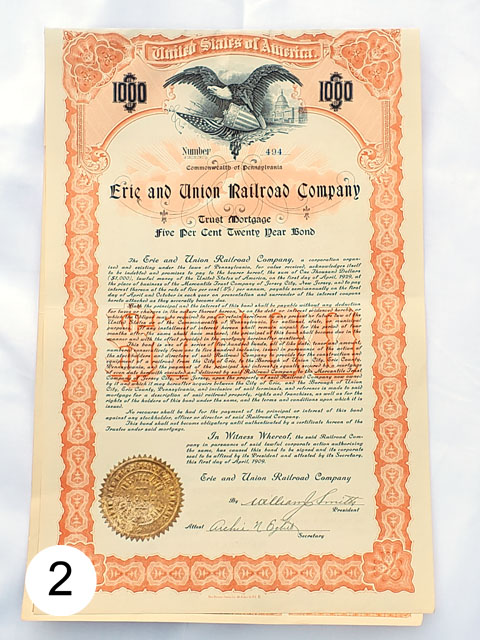
|
|
Does anyone think the distorted image will sell better than the alternative?
(There are seldom good excuses for showing distorted certificates.)
|
For quite some time, I have kept notes of both sensible and pathetic selling attempts on eBay. Yes, horrible presentations can sell. I just don't understand why any seller would settle for horrible pictures and descriptions when it is pathetically easy to do better.
The number of potential buyers
Certificate sellers are entirely at the mercy of eBay's ability to attract collectors. It is true that eBay brings huge numbers of collectors to its site every day. So what? Only a microscopic fraction of eBay visitors are interested in collectible certificates.
Sellers cannot affect the number of collectors eBay brings to its site. Nor can they filter good buyers from bad or rich buyers from poor. Therefore, sellers need to situate their offerings where the greatest number of people will see their inventories. That means choosing proper listing categories.
There are two main categories where railroad stocks and bonds are routinely offered:
Category 1
Collectibles and Art > Coins and Paper Money > Stocks and Bonds > Transportation Stocks and Bonds > Railroad Stocks and Bonds
- 5,500 to 6,000 offerings displayed at any one time.
- Roughly 1,000 sales per month.
- Sell-through rate about 15% to 18%.
Category 2
Collectibles and Art > Collectibles > Transportation > Railroadiana and Trains > Paper > Stock Certificates and Bonds
- 1,500 to 2,000 offerings displayed at any one time.
- Roughly 150 sales per month.
- Sell-through rate about 8% to 10%.
Category 1sees more competition than Category 2 but its sell-through percentage is almost twice as good. That tells me that Category 1 attracts three times more railroad stock and bond collectors than Category 2. There is no way to count the number of buyers who participate in both categories so I am forced to suggest sellers list items where there are the most eyeballs.
I know contrarians will want to try selling certificates in categories where there is less competition. I understand the enticement. I will make two suggestions, however.
First, eBay sellers in the stock and bond hobby are more in competition with themselves than with others. Second, I think that when seeking profit, it is usually better to face facts than opinions.
The closest correlatives to scripophily are the coin, paper money, and stamp hobbies and yet, stock and bond collecting is barely known among those collectors. I can't help but wonder how profitable it will be to try selling in categories that are even further afield than coins, currency. and stamps.
If sellers want to experiment with off-topic categories, great. List items in both Category 1 and some other category. After items sell, ask buyers which category they found offerings in. Quantify which category gives the best results. Maybe contrarians will prove my predictions wrong.
Titling
EBay allows titles to be as long as 80 characters. Some online experts suggest shorter titles are better than long ones. I personally have no opinion on length because I have not tracked that variable.
I DO have opinions on title content, however.
- Focus, focus, focus on what is being sold and avoid everything else.
- Put railroad company names first
- Studies on comprehension and reading speed have shown that text composed of upper and lower case letters are easier and faster to read than ALL CAPS.
- Avoid abbreviations that are not blatantly obvious. 'RR' and '&' are okay. Personally, I would spell 'Railway.'
- Avoid punctuations if possible. Punctuations count toward eBay's 80-character limit.
Describing and illustrating certificates
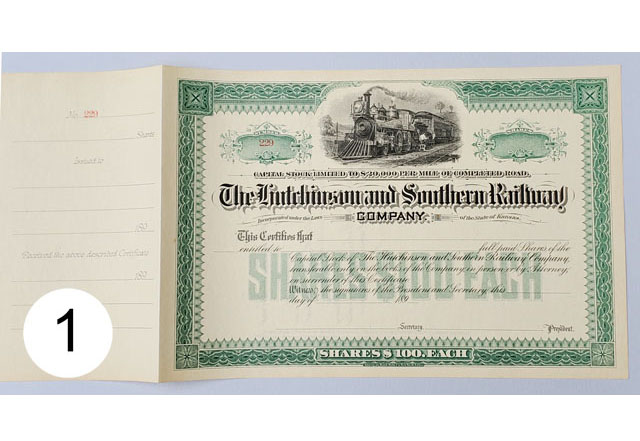
|
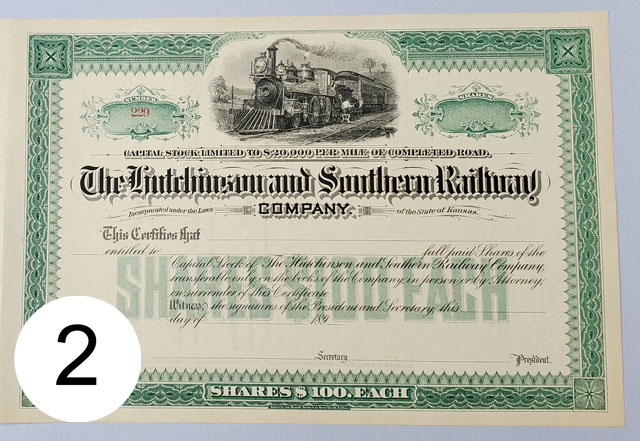
|
|
WHY show the stub? Isn't the full certificate more enticing?
(Stubs were never parts of securities, so why show them?)
|
David Ogilvy summarized his lifelong experience in marketing with the phrase, "The more you tell, the more you sell." I can only imagine what the acknowledged "father of advertising" might have said about the remarkable tendency of eBay buyers to completely ignore written descriptions.
I am sure Ogilvy would have created a clever and insightful slogan for marketing on eBay, but the essential idea on eBay is: "More show equals more dough."
It is my experience that very few collectors read past listing titles. I have been stunned by the number of eBay shoppers who have messaged me with questions about offerings when I had already answered those facts in descriptions, often in BOLD type.
Descriptions are searchable on eBay. That capability is a terrific reasons for writing short, informative, and on-point descriptions. Nonetheless, just because buyers might encounter seller descriptions does NOT mean they will read them. Therefore, It becomes even more important to be precise when writing titles.
Imitate the pros
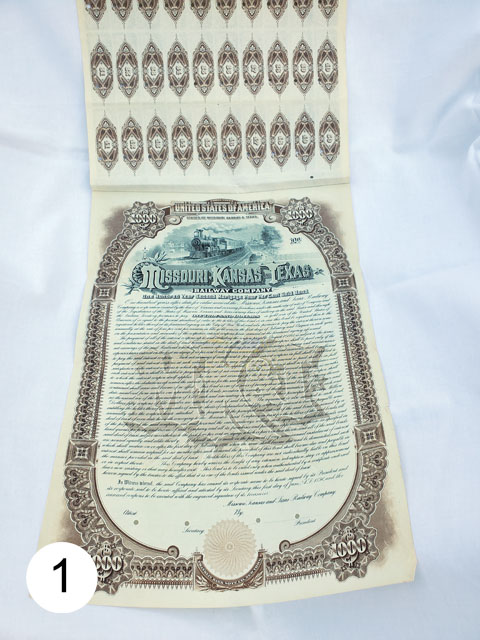
|
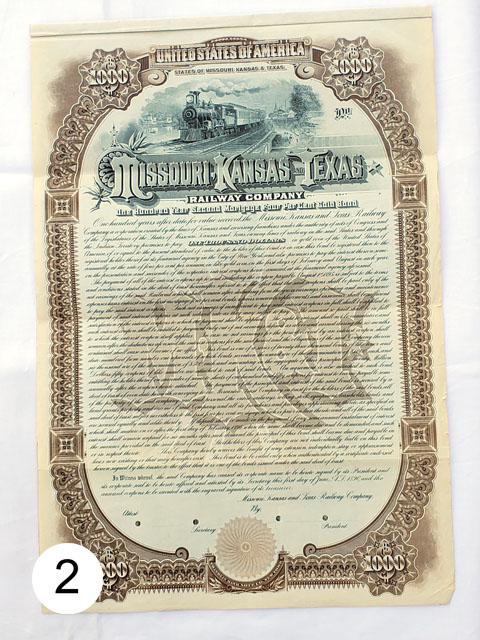
|
|
Is this an effort to sell coupons or a bond?
(Aren't we in the hobby of collecting stocks and bonds?)
|
There is room for even professional sellers to improve their listings to increase sales and prices, but they are already doing MORE things right than amateurs. New sellers can shorten the learning curve by imitating the best. They can find out what the best sellers are doing and imitate their practices.
Other concepts
Avoid selling certificates in multi-item lots unless in a really big hurry. Multi-item lots are the surest way to receive the least amount of money possible. That includes even two-item lots. Selling items in two-item lots is like selling one item at a discount and giving the other away free. Don't sell in multi-item lots unless absolutely necessary.
Avoid selling multiple copies of the same certificate design on the same day. Wait until the first item sells in order to adjust expectations of price. If anticipating selling similar items over the course of several months, spread out sales of similar items even more. Many collectors visit eBay every day and become very aware of sellers who offer the same varieties week after week. If buyers have seen certificates sell for $25 every month for the last six months, they are extremely unlikely to bid $30 next month.
Avoid using stock images unless items are extremely common. The rationale for using stock images is justifiable when selling cheap, unissued and unnumbered remainders. I'll even accept that reasoning when trying to sell super-common, late-date certificates known in quantities of thousands. However, buyers know every certificate is different and they want to know exactly what they are buying.
Beyond this point...
From this point on, I make blunt suggestions about selling based on practices I see constantly on eBay.
I will make suggestions about Titles, Descriptions, Images. and Prices.
I do not intend to offend, but bluntness creates that possibility. Some readers may see themselves in my comments. I cannot possibly know who will read this page today, let alone months or years into the future. I cannot soften every comment to preserve tender feelings. If someone might take offense at my describing typical eBay listing problems, I beg them to:
STOP RIGHT HERE. Go to another page or another website. Please.
Suggestions
In old fashioned, pre-internet mail order, it was accepted practice to search out and cater to specific kinds of buyers. That kind of selection is not possible on eBay or any other auction platform I have seen. In the case of stocks and bonds, I personally believe it wise to cater what I call, "Better Buyers." How can that be done?
When I use the term "Better Buyers," I'm referring to collectors with experience. They are the kinds of buyers who know precisely what they want. Most have defined specialties. They are not necessarily rich. They may be living on a pensioner's budget, but they are collectors who know the hobby and understand rarity, desirability, and value. Most importantly, they are dependable buyers who intend to be in the hobby for the long haul. Every seller will have a different definition.
Unlike pre-internet mail order, sellers have no easy way to find those kinds of eBay buyers except through their certificate listings. Chances would be vastly improved if every eBay shopper read descriptions, but that is an impossibility. That means sellers have merely their titles, images, and prices to do all their heavy lifting. That is a very, very tall order. Nonetheless, if sellers can form their own visions of their "Better Buyers," keep those visions front and center in their mind, and cater directly to that imaginary group, they will do as well as possible.
Titles
- Always display full company names in titles even at the expense of dropping other wording.
- Issuance dates and state names are good in titles IF known, but always secondary to company names.
- Don't guess dates when selling unissued remainders. "18___" is good enough
- Avoid abbreviations in titles. Sellers might think abbreviations make them sound "professional." In truth, abbreviations introduce confusion .Confused minds are not good buyers.
- Avoid puff words in titles. "Beautiful," "Fantastic," "Stunning," "Top," and "Super" are in the eyes of beholders. Puffery never convinces "Better Buyers" to buy.
- Avoid population estimations such as "rare," "scarce," "one-of-a-kind," and "unique." I view those terms as uninformed exaggerations. Are "Better Buyers" going to think differently?
- Avoid meaningless condition words like "super," "crisp" and "mint." "Super" is overused. "Crisp" is simply a word for ordinary paper with "body." Dry leaves are "crisp." Highly sunburned and aged certificates are "crisp." The word "mint" is utter nonsense. Paper is printed, not minted. "Mint" has a long history of use in philately, but that is not a good reason to extend its use to scripophily.
- Age-related words seldom help sales. "Antique" commonly refers to items older than 100 years and, even then, generally to objects like furniture, art, and glassware. "Old" and "vintage" hold personal meanings. The hobby's "best buyers" are probably older than fifty. They are not going to use "old" and "vintage" for any certificate issued within their lifetimes.
- Avoid promoting "low serial numbers." Price history proves conclusively that collectors do NOT pay premiums for serial numbers above #3 and rarely even above #2.
- Avoid promoting signatures unless genuinely significant as collectible autographs.
Descriptions
- Mention whether certificates are cancelled or not. Collectors usually pay more for uncancelled certificates. Certificates that were Issued but never cancelled often fetch premiums, so mention such features. Mention cancellations when they are small and invisible in images.
- Avoid long passages of text extracted from Wikipedia. Buyers seldom read descriptions, let alone extended text. If sellers find certain facts in Wikipedia articles that are genuinely important, on-topic, will help sell certificates, I advise re-writing so it makes sellers appear more knowledgeable. Wikipedia extractions make sellers look amateurish and lazy.
- Describe non-ordinary problems. It is entirely normal for collectible certificates to have problems. It is not necessary to describe every fold, wrinkle, and staple hole, but it is a good idea to mention things like tape, tears, invisible cut cancels, water stains, and brittleness. The majority of eBay buyers will probably ignore descriptions, but they will not be able to say that sellers did not warn them.
- Cut down on answering inquiries. There are some eBay shoppers who drive sellers crazy with questions. Answer a few such inquiries and repetitive names become noticeable. After a few answers that fail to turn into sales, sellers can begin ignoring them.
- List issue dates in descriptions (when applicable), Do NOT list cancellation or transfer dates.
- Focus descriptions on certificates being sold. It will save lots of time. I advise against wasting time researching and writing company histories. People are buying certificates, not histories
Images
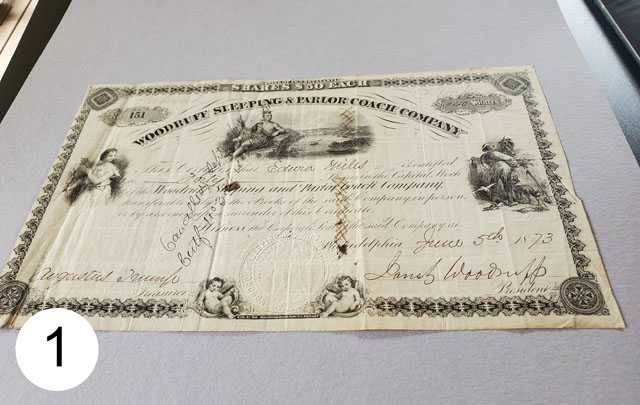
|
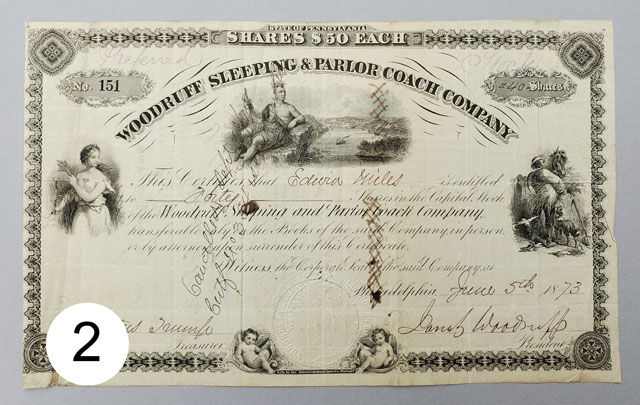
|
|
Does anyone think the distorted image would sell better that the alternative?
(Certificates are rectangular; display them that way.)
|
Images are the first things most eBay viewer look for. That usually means thumbnail images, If large pictures look bad, thumbnails will look worse.
Improving image quality is probably the single best way to improve the chances of sale on eBay. Scanners are the best way to get good images. The majority of eBay sellers seem to post cell phone photographs and those are acceptable as long as they are bright and oriented correctly. Here are a few suggestions to eliminate some of the biggest problems I see in eBay offerings.
- The best photos are those that are exposed well and free of odd colors, and other distractions. If photos come out looking weird, re-shoot.
- Sales takes several days to close, so there are rarely good reasons not to try to get better images. After all, we're talking about money here. I don't know of a good reason to use a junk photo.
- Use a scanner if certificates cannot be photographed adequately well. Scanners are usually available at copy centers. The majority of stock certificates are larger than 8½ x 11 so it will be necessary to locate a scanner capable of scanning 11"x17."
- If sellers refuse to locate larger scanners, then use cell phone images. Always show correctly-oriented, well-lighted, full certificates as primary photos for listings. Never use partial images for primary pictures.
- Always show picture of the FRONTS of certificates as primary images.
- Show full margins. Do not cut off sides or bottoms of certificates.
- Never use the folded backs of bonds as primary pictures.
- If relying on photos, make sure certificates are flat before photographing. If a certificate is terribly delicate or impossible to unfold and flatten, find a scanner. Images of folded certificates rarely fetch good prices even if certificates are rare.
- Remove certificates from holders before photographing or scanning. Otherwise, glare and low bids result.
- FOCUS ALL ATTENTION ON CERTIFICATES BEING SOLD.
- Keep hands and fingers out of photos. They are distracting. The goal is to focus ALL attention on certificates being sold.
- Avoid distracting backgrounds. Focus ALL attention on certificates, not backgrounds.
- Avoid bright colored backgrounds because colors show through and often make certificates look ugly and sick. Red, yellow or green backgrounds are especially bad.
- Avoid using quilts, shag carpets, or bathroom mats as backgrounds. They are distracting and scream "AMATEUR" to Better Buyers. Go to a hobby store and purchase neutral gray or black posterboards for backgrounds. (Black makes thin paper look dull and under-exposed. In my opinion, light gray is the best. Very pale blue is good for certificates that look yellow in photographs.)
- Use good lighting. Poor exposure is disastrous from a sales perspective. Some collectors have told me they specifically look for poor photos because they know they can usually win with "bottom feeder" bids. Those buyers tell me they assume that poor pictures mean that sellers don't care about their certificates and are in a big hurry to sell at any price.
- Eliminate rulers, dollar bills, and everything else used for scale. Better Buyers know how certificates are sized. Rulers, dollar bills, coins, hands, and other things are distractions. Focus on certificates.
- Photograph or scan backs of certificates ONLY when there is something important there. I have never met or corresponded with a single collector who was interested in the backs of certificates unless there was something unusual there.
- Do NOT use vignettes as primary eBay images. Sellers should scan vignettes and other details as they see fit. However, always use certificates as primary images. Always try to prevent would-be buyers from "guessing" what certificates sellers might be offered.
- Use images of full certificates as primary eBay images. Sellers should never use vignettes unless they are selling vignettes, in which case, show the whole card.
- Do not overprint user names or phrases like "EBAY IMAGE" on photographs. Professional sellers don't do that. Why should amateurs?
- If photographing certificates with cell phones, orient them so certificates almost fill up screens. Make sure certificates are well lit without any odd green or orangish overtones from fluorescent or incandescent lights.
- EBay allows images as large as 1600 x 1600 pixels. USE ALL THAT SPACE. EBay does not enlarge small images. It is true that certificates illustrated by small images can and do sell, but rarely for as much as when illustrated by large images.
- Many sellers like to use space around certificates in order to show edge details. That is an acceptable idea as long as margins don't exceed a ½-inch in width. Anything more than that is taking up space that could be used to better show items being sold.
- Always make images "right-reading" before posting on eBay. There are many free image manipulation apps available on the web. Never force viewers to cock their heads sideways to view certificates.
- Make images as rectangular as possible. Again, There are many free image manipulation apps available on the web.
- Do NOT cant images in some "artsy" attempt to make them look like images in magazines. Collectors are shopping for certificates, not stylish knick-knacks or some expensive health product. Imitate professional certificate sellers.
- Save images as medium quality JPGs. They are the fastest-loading images.
- Avoid PNG, TIF, and GIF image files unless there are specific purposes other than eBay. Those file types are all much larger than JPGs, and consequently load more slowly. JPGs always work on the slowest devices and oldest browsers.
- It is not necessary to show large numbers of coupons when selling bonds. Collectors are buying bonds, not coupons.
- There is no need to show stubs.. Stubs merely consume valuable space that can be used to show certificates. Exceptions may include extremely rare instances where celebrities signed stubs. Just be absolutely certain that signatures came from celebrities themselves and not from brokerage clerks.
- Do NOT promote certificates as "perfect for framing." Better Buyers are not interested in framing certificates.
Prices
Prices are all over the place on eBay. I routinely record "4x" ranges of prices paid for certificates. By that I mean the very same variety and condition of certificate can sell for $25 on eBay one day and $100 the next. Ranges of prices paid on eBay for identical certificates are very high.
Sellers need to be "reasonable" in setting start prices. I always suggest consulting past sales to see what certificates have sold for over the last three months. DO NOT, DO NOT, DO NOT use current offerings for guides. Those are wishes, not facts.
We already know there are high-price dealers and low price dealers among professionals. High-ticket auction houses like Christie's can co-exist with low-price farm auctions. There is room for almost every pricing strategy. My experience is that buyers rarely if ever consult past sale prices on eBay. Even if they do, a three-month look-back period is short, so buyers' memories are somewhat restricted. Therefore, sellers have some degree of immunity from past prices. If sellers want to make money on eBay, they need to push the envelope upward when selling scarcer certificates, not the opposite. Obviously, sellers need to preserve the impression of having "reasonable" prices.
If a particular variety has sold in the past three months for $20, $30, and $40, I'd probably start an auction at $30. If more desirable certificates had sold for $100, $200, and $300, I'd probably start at $225. If it had been more than three months since those same certificates had sold, I'd even consider starting prices a bit higher.
If I were unsuccessful at selling certificates at those prices, I would NOT immediately re-list. Unless I were in a hurry, I would wait six to eight weeks and lower prices a bit.
Is it wise to offer $200 collectible on eBay? Might it not be better to consign to a professional auction house? I'd prefer to offer certificates like that where there are more "Better Buyers."